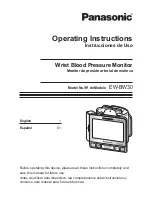
15
English
1 IR IN, IR OUT:
Infrared Signal Input / Output
Terminal
Use this when operating more
than one display with one remote
control.
2 SERIAL IN,
SERIAL OUT:
SERIAL Input / Output Terminal
Control the Display by connecting
to PC.
3 AUDIO OUT:
Analogue Audio Output
Terminal
Connect to audio equipment with
analogue audio input terminal.
4 AV IN:
Composite Video / Audio Input
Terminal
Connect to video equipment with
Composite signal output.
Audio input is shared by AV IN,
DVI-D IN and PC IN.
5 USB:
USB Terminal
Connect the USB memory to use
“USB media player” or “Memory
viewer”. Also, this can be used to
supply power of up to 5V/1A to an
external device when the picture
is displayed.
6 DVI-D IN,
DVI-D OUT:
DVI-D Input / Output Terminal
Connect to video equipment
with DVI-D output. Also, when
displaying the picture by daisy
chaining multiple displays,
connect to the other display
(DVI-D OUT).
The DVI-D output function is
enabled only for the DVI input.
Note this is not output if the
HDMI or DIGITAL LINK input is
selected.
7 AV IN
(HDMI 1,
HDMI 2):
HDMI Input Terminal
Connect to video equipment such
as VCR or DVD player, etc.
8 DIGITAL LINK /
LAN:
DIGITAL LINK / LAN Terminal
Control the Display by connecting
to Network. Alternatively, connect
to a device that sends video and
audio signals via the DIGITAL
LINK terminal.
9 PC IN:
PC Input Terminal
Connect to video terminal of PC,
video equipment with “YP
B
P
R
/
YC
B
C
R
” or “RGB” output.
10 LAN:
LAN Terminal
Control the Display by connecting
to Network.
Video equipment connection
DIGITAL LINK
10
*
1
*
2
*
1: TH-65SF2E
*
2: TH-65SF2U, TH-55SF2U, TH-49SF2U, TH-43SF2U, TH-55SF2E, TH-49SF2E, TH-43SF2E
Summary of Contents for TH-55SF2U
Page 27: ...27 English Customer Service ...














































